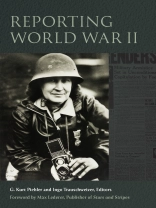This set of essays offers new insights into the journalistic process and the pressures American front-line reporters experienced covering World War II. Transmitting stories through cable or couriers remained expensive and often required the cooperation of foreign governments and the American armed forces. Initially, reporters from a neutral America documented the early victories by Nazi Germany and the Soviet invasion of Finland. Not all journalists strove for objectivity. During her time reporting from Ireland, Helen Kirkpatrick remained a fierce critic of that country’s neutrality. Once the United States joined the fight after the Japanese attack on Pearl Harbor, American journalists supported the struggle against the Axis powers, but this volume will show that reporters, even when members of the army sponsored newspaper, Stars and Stripes were not mere ciphers of the official line.
African American reporters Roi Ottley and Ollie Stewart worked to bolster the morale of Black GIs and undermined the institutional racism endemic to the American war effort. Women front-line reporters are given their due in this volume examining the struggles to overcome gender bias by describing triumphs of Thérèse Mabel Bonney, Iris Carpenter, Lee Carson, and Anne Stringer.
The line between public relations and journalism could be a fine one as reflected by the U.S. Marine Corps’ creating its own network of Marine correspondents who reported on the Pacific island campaigns and had their work published by American media outlets. Despite the pressures of censorship, the best American reporters strove for accuracy in reporting the facts even when dependent on official communiqués issued by the military. Many wartime reporters, even when covering major turning points, sought to embrace a reporting style that recorded the experiences of average soldiers. Often associated with Ernie Pyle and Bill Mauldin, the embrace of the human-interest story served as one of the enduring legacies of the conflict.
Despite the importance of American war reporting in shaping perceptions of the war on the home front as well as shaping the historical narrative of the conflict, this work underscores how there is more to learn. Readers will gain from this work a new appreciation of the contribution of American journalists in writing the first version of history of the global struggle against Nazi Germany, imperial Japan, and fascist Italy.
قائمة المحتويات
Foreword
Max D. Lederer Jr. | vii
Introduction
G. Kurt Piehler and Ingo Trauschweizer | 1
1. Learning and Adapting:
The American Media and the “Phony War, ” September 1939–April 1940
Steven Casey | 15
2. Helen Kirkpatrick’s Reporting to Undercut Irish Neutrality Policy, 1939–1942
Karen Garner | 34
3. Miss Bonney Reporting from the Arctic Front
Henry Oinas-Kukkonen | 55
4. Reporting from the Bureaus:
The Lesser-Known World War II Correspondents
Kendall Cosley | 85
5. Two African American Journalists Confront World War II:
Perspectives on Nationalism, Racism, and Identity
Larry A. Greene and Alan Delozier | 107
6. Bylines and Bayonets: How United States Marine Corps
Combat Correspondents in World War II Blended Journalism and Public Relations
Douglass K. Daniel | 132
7. Reporting Reconnaissance to the Public:
A Comparative Analysis of Canadian and American Strategies
Victoria Sotvedt | 159
8. Outstanding and Conspicuous Service:
Iris Carpenter, Lee Carson, and Ann Stringer in the European Theater
Carolyn M. Edy | 172
9. A “Butcher and Bolt” Force:
Commandos, Rangers, and Newspaper Dramatics in World War II
James Austin Sandy | 193
10. “A Major Readjustment”: Omar Bradley’s War against the Stars and Stripes
Alexander G. Lovelace | 213
11. After the Shooting Stopped: Justice and Journalism at Nuremberg
Nathaniel L. Moir | 234
Acknowledgments | 259
List of Contributors | 261
Index | 265
عن المؤلف
G. Kurt Piehler is the author of A Religious History of the American GI in World War II (2021) and several reference works related to war and society. He is a member of the editorial board of the Service Newspapers of World War II digital publication (Adam Mathews) and on the advisory board of the NEH-funded American Soldier Project at Virginia Tech University (americansoldierww2.org).












